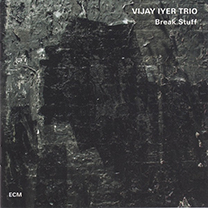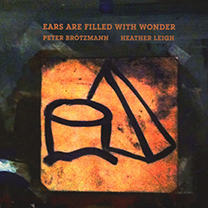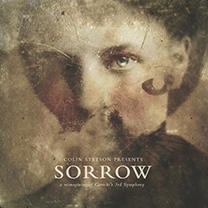July 26, 2016
One Dozen Sides of Vinyl
As the creator and instructor of a course titled, The Golden Age of Non-Idiomatic Improvisation at the University of Tennessee, I have the happy opportunity of sharing my love of the heroes of improvised music with young people. We examine not only the music but the philosophy and motivation of folks who have devoted their lives to creative endeavors in the cultural margin. The course began as a response to the deaths of a couple of my favorite musicians, the British guitarist, Derek Bailey (1930-2005), and the German guitarist and daxophonist, Hans Reichel (1949-2011). Originally, the course focused on musicians born in the 1930's and the 1940's. I wanted to do my part to help this often over-looked cultural treasure be passed on to the next generation.
The course will be offered for the sixth time in the Fall semester of 2016. (Schedule here.) Each time it has been offered, the course focuses on a rotating and gradually expanding cast of musicians. However, invariably a natural response of the students is to think about who is continuing the tradition in subsequent generations, perhaps even in their own generation. These students are born in the 1990's. To this end, as the instructor I have embarked on expansion of my own musical horizons, trying to discover musicians who are closer in age to the students than they are to me. I have made only modest progress, managing to introduce musicians born in the 1960's, 1970's and 1980's. This review of these dozen sides of vinyl comes about as part of this effort. (Also as part of a similar effort, see the review of four Mary Halvorson cds in The International Journal of Exploratory Meta-Living.) My cumulative reaction to these various musics is the observation that there is a group of exceptionally talented young people continuing to make non-idiomatic music in the world. We are lucky listeners living in this day and age. However, it is all too easy to ignore these voices. One has to actively seek them out. Here we briefly review four releases from 2015 and 2016 of some relevance to this subject.
Sides 1-2: Colin Stetson & Sarah Neufeld - Never Were the Way She Was
(Constellation Records, CST113-1, 2015, lp)
 To say that Stetson has a unique way with saxophones is an understatement. His playing possesses a visceral element that is impressive in a live setting and carries through even in a recording. I had heard him only in solo settings (the three volumes of New History of Warfare) and in a saxophone duo with Swedish free improv player, Mats Gustafsson (Stones). In these settings his prodigious talent, his incredible breadth of technique and his singular vision is all on full display. That he can simultaneously coax three sounds from a single saxophone--a breathy drone, a percussive rhythm and a melodic voice--is a talent that, to my knowledge, no one else on Earth is able to duplicate. If I had a single quibble with New History of Warfare, it would be his fondness for adding vocal tracks (from the likes of Laurie Anderson) over his playing, which adds a pop-like appeal to his records at the expense of the undiluted message of the instrument. (To be honest, each volume contains numerous instrumental tracks, so probably I am being unnecessarily picky.)
To say that Stetson has a unique way with saxophones is an understatement. His playing possesses a visceral element that is impressive in a live setting and carries through even in a recording. I had heard him only in solo settings (the three volumes of New History of Warfare) and in a saxophone duo with Swedish free improv player, Mats Gustafsson (Stones). In these settings his prodigious talent, his incredible breadth of technique and his singular vision is all on full display. That he can simultaneously coax three sounds from a single saxophone--a breathy drone, a percussive rhythm and a melodic voice--is a talent that, to my knowledge, no one else on Earth is able to duplicate. If I had a single quibble with New History of Warfare, it would be his fondness for adding vocal tracks (from the likes of Laurie Anderson) over his playing, which adds a pop-like appeal to his records at the expense of the undiluted message of the instrument. (To be honest, each volume contains numerous instrumental tracks, so probably I am being unnecessarily picky.)
On Never Were the Way She Was, Stetson is joined by Sarah Neufeld on violin. The violin is of course an instrument that has been long commandeered by Western classical music. If one maintains a philosophical objection to the unequal roles between composer and musician, hearing the violin likely triggers a knee-jerk reaction to "change the dial". Here however, a very esthetically pleasing density of sound is created through the combination of Stetson's saxophone and Neufeld's violin. The tracks are melodic; the balance between improvisation and composition is not entirely clear. While the presence of some predetermined composition is undeniable, one hesitates to suggest there is no improvisational element as well. It seems a trademark of this younger generation of non-idiomatic musicians that the immediately recognizable "free improvisation" of earlier generations has mingled with composition to the point that it is no longer trivial to distinguish the borders between the two. Many of the tracks possess a frenetic energy, that conjures up images of Stetson's face turning beet red as he maintains the continuous stream of music. Several tracks on Never Were the Way She Was, including the title track, possess a solemnity, that is both gorgeous and contemplative.
Sides 3-6: Vijay Iyer Trio - Break Stuff
(ECM Records, ECM 2420 472-4304, 2015, lpx2)
 I read some reviews of this album by people who know alot more about Iyer than do I. (See John Kelman's review in All About Jazz.) Of Iyer, I knew only A Cosmic Rhythm with Each Stroke, a duo with trumpeter Wadada Leo Smith, both from a live performance and the studio recording. I had a pretty high opinion of Iyer, based on that limited information; the live show at the Big Ears Festival was the best concert I have seen in the first sixteen years of the twenty-first century. This piano/bass/drums trio in Break Stuff (with Stephan Crump & Marcus Gilmore) is by no means a disappointing second introduction to Iyer's work. I suppose one can think of it as jazz, if it helps, although so many folks in non-idiomatic improvisation worked to free themselves of that label (for various practical and philosophical reasons) that it seems counter-productive to re-attach it to an heir of their traditions in a subsequent generation. As was the case with Stetson & Neufeld, there is an ambiguous mixture of composition and improvisation. I felt very much the same response as I did to Dragon's Head, the guitar/bass/drums recording by the Mary Halvorson trio. One can listen to each track. One can listen to the album in its entirety several times. Each listening seems new. One may argue that the lack of memorable riff is a deficiency, but that argument is easily countered by the notion that such metrics only apply to popular songs, intended for commercial markets, and not to music that "embodies cognition". Having listened to the album half a dozen times already I accept that I have yet to receive the intended message and at the same time I found absolutely no flaw in the music. I particularly enjoyed, the three bird songs, Starlings, Geese, Wren, played back to back. The whole album displays a self-possessed and unpretentious magnificence. (This album contains re-interpretations of Monk, Strayhorn & Coltrane, but we shall briefly postpone our comments on re-interpretations.)
I read some reviews of this album by people who know alot more about Iyer than do I. (See John Kelman's review in All About Jazz.) Of Iyer, I knew only A Cosmic Rhythm with Each Stroke, a duo with trumpeter Wadada Leo Smith, both from a live performance and the studio recording. I had a pretty high opinion of Iyer, based on that limited information; the live show at the Big Ears Festival was the best concert I have seen in the first sixteen years of the twenty-first century. This piano/bass/drums trio in Break Stuff (with Stephan Crump & Marcus Gilmore) is by no means a disappointing second introduction to Iyer's work. I suppose one can think of it as jazz, if it helps, although so many folks in non-idiomatic improvisation worked to free themselves of that label (for various practical and philosophical reasons) that it seems counter-productive to re-attach it to an heir of their traditions in a subsequent generation. As was the case with Stetson & Neufeld, there is an ambiguous mixture of composition and improvisation. I felt very much the same response as I did to Dragon's Head, the guitar/bass/drums recording by the Mary Halvorson trio. One can listen to each track. One can listen to the album in its entirety several times. Each listening seems new. One may argue that the lack of memorable riff is a deficiency, but that argument is easily countered by the notion that such metrics only apply to popular songs, intended for commercial markets, and not to music that "embodies cognition". Having listened to the album half a dozen times already I accept that I have yet to receive the intended message and at the same time I found absolutely no flaw in the music. I particularly enjoyed, the three bird songs, Starlings, Geese, Wren, played back to back. The whole album displays a self-possessed and unpretentious magnificence. (This album contains re-interpretations of Monk, Strayhorn & Coltrane, but we shall briefly postpone our comments on re-interpretations.)
Sides 7-8: Heather Leigh & Peter Brötzmann - Ears Are Filled With Wonder
(Trost Records, TR 147, 2016, lp)
 I didn't know anything about Heather Leigh, a West Virginian pedal steel guitarist, relocated to Scotland. I had heard that she released an album titled I Abused Animal on Stephen O'Malley's imprint, Ideologic Organ, (which also is home to the incredible Nazoranai releases featuring guitar/bass/drums trio of Keiji Haino, O'Malley and Oren Ambarchi). I didn't pursue this album because I really don't have any interest in the abuse of animals, even on a metaphorical level. Still, I anticipated in the combination of Leigh and Peter Brötzmann, the kind of synergystic inter-generational greatness that was on display with Iyer and Smith on A Cosmic Rhythm with Each Stroke. I was not disappointed. Here there can be little question regarding the balance between improvisation and composition; Brötzmann wails leave little doubt. At times, Leigh provides a kind of background cascade to the punctuated bursts of saxophone. At other times, the electric pedal steel guitar moves to the forefront and participates in a duet of featured voices. Both aspects are enjoyable, although it seems to me that Brötzmann is the star of the show and Leigh (at this time) remains an accompanist given a chance to solo during the performance.
Leigh has a discography of her own, of which I know nothing. On several albums she is credited with vocals in addition to steel guitar. Ears Are Filled With Wonder has no vocals other than that rendered by the squeals of Brötzmann's saxophone. It seems further investigation of Leigh is warranted, so long as she can steer clear of topics inherently associated with cruelty.
I didn't know anything about Heather Leigh, a West Virginian pedal steel guitarist, relocated to Scotland. I had heard that she released an album titled I Abused Animal on Stephen O'Malley's imprint, Ideologic Organ, (which also is home to the incredible Nazoranai releases featuring guitar/bass/drums trio of Keiji Haino, O'Malley and Oren Ambarchi). I didn't pursue this album because I really don't have any interest in the abuse of animals, even on a metaphorical level. Still, I anticipated in the combination of Leigh and Peter Brötzmann, the kind of synergystic inter-generational greatness that was on display with Iyer and Smith on A Cosmic Rhythm with Each Stroke. I was not disappointed. Here there can be little question regarding the balance between improvisation and composition; Brötzmann wails leave little doubt. At times, Leigh provides a kind of background cascade to the punctuated bursts of saxophone. At other times, the electric pedal steel guitar moves to the forefront and participates in a duet of featured voices. Both aspects are enjoyable, although it seems to me that Brötzmann is the star of the show and Leigh (at this time) remains an accompanist given a chance to solo during the performance.
Leigh has a discography of her own, of which I know nothing. On several albums she is credited with vocals in addition to steel guitar. Ears Are Filled With Wonder has no vocals other than that rendered by the squeals of Brötzmann's saxophone. It seems further investigation of Leigh is warranted, so long as she can steer clear of topics inherently associated with cruelty.
Sides 9-12: Colin Stetson - Sorrow (A Reimagining Of Górecki's 3rd Symphony)
(52Hz Records, 52HZ001LP, 2016, lpx2)
 I was one of the million people who made Górecki's 3rd Symphony a million cd seller when it was released on Nonesuch in 1992. It is a lovely piece, despite the fact that it required a composer to impose his will on the musicians of an orchestra in order to create the work. In this release, Stetson assembles an ensemble of his own to re-interpret the music. It is a surprisingly faithful rendition. The trademark saxophone of Stetson is dominant only sporadically. It is clear that this album is a reverentially executed labor of love. However, my first thought on hearing it was, "Why am I not listening to the original?" The re-interpretation of a work seems fraught with controversy. On the one hand, it provides an opportunity for one artist to pay honest homage to another. Such tributes are commonplace; many musicians, idiomatic and otherwise, routinely participate in such exercises. At the same time, re-interpretations are by definition derivative. It is difficult to add something so that the new version is preferable to the original, which had, of course, as a mainstay of its appeal, originality! So I stopped playing Stetson's version midway through and returned to the original for the next couple days. Then I returned to Stetson's version and found it pleasant, all other arguments aside. Is it preferable to the original? No, but I don't think that Stetson imagined his work as a replacement. Instead, it may bring the music to new ears (and remind old ears as well). Some of those ears may be led to the original, and through that to Miserere and Good Night and other orchestral and choral works of Górecki.
I was one of the million people who made Górecki's 3rd Symphony a million cd seller when it was released on Nonesuch in 1992. It is a lovely piece, despite the fact that it required a composer to impose his will on the musicians of an orchestra in order to create the work. In this release, Stetson assembles an ensemble of his own to re-interpret the music. It is a surprisingly faithful rendition. The trademark saxophone of Stetson is dominant only sporadically. It is clear that this album is a reverentially executed labor of love. However, my first thought on hearing it was, "Why am I not listening to the original?" The re-interpretation of a work seems fraught with controversy. On the one hand, it provides an opportunity for one artist to pay honest homage to another. Such tributes are commonplace; many musicians, idiomatic and otherwise, routinely participate in such exercises. At the same time, re-interpretations are by definition derivative. It is difficult to add something so that the new version is preferable to the original, which had, of course, as a mainstay of its appeal, originality! So I stopped playing Stetson's version midway through and returned to the original for the next couple days. Then I returned to Stetson's version and found it pleasant, all other arguments aside. Is it preferable to the original? No, but I don't think that Stetson imagined his work as a replacement. Instead, it may bring the music to new ears (and remind old ears as well). Some of those ears may be led to the original, and through that to Miserere and Good Night and other orchestral and choral works of Górecki.

